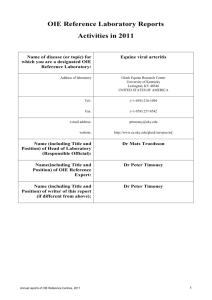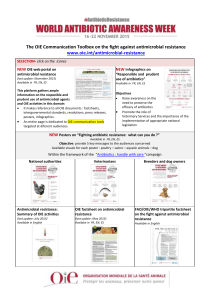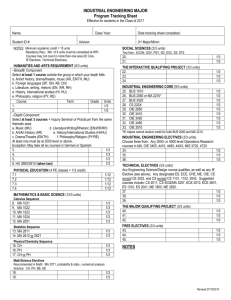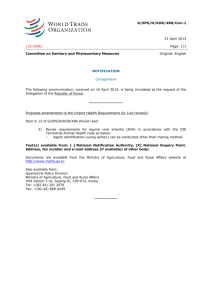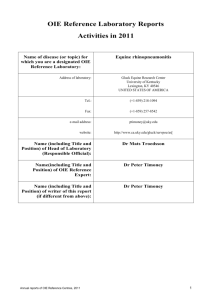RK-13 cell culture
advertisement
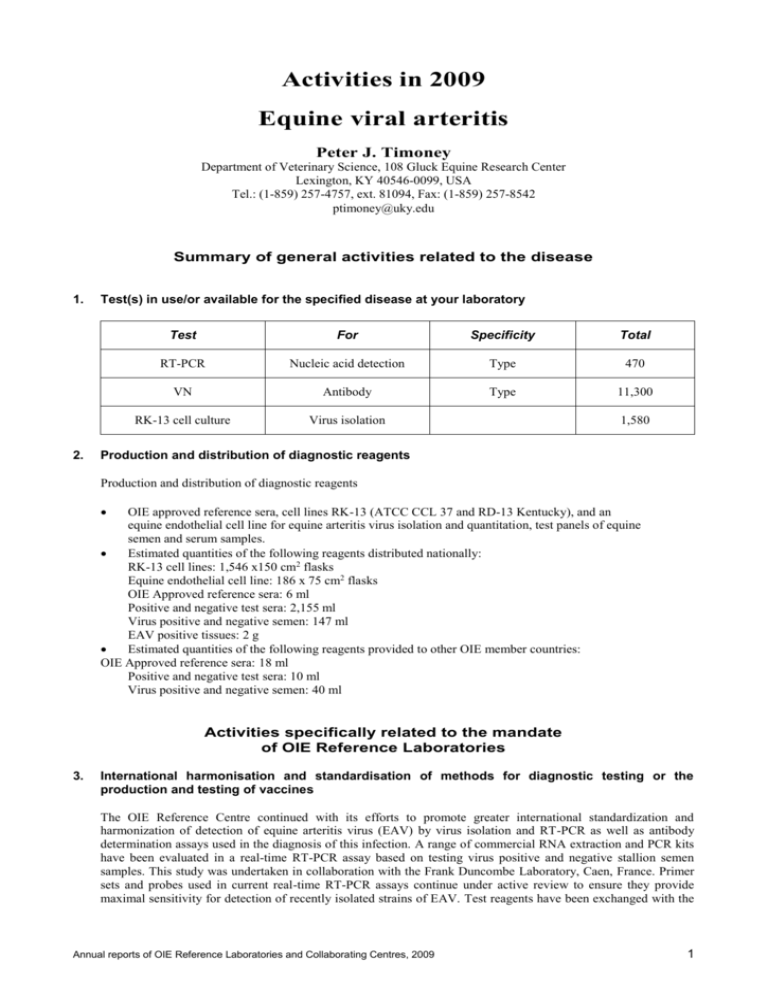
Activities in 2009 Equine viral arteritis Peter J. Timoney Department of Veterinary Science, 108 Gluck Equine Research Center Lexington, KY 40546-0099, USA Tel.: (1-859) 257-4757, ext. 81094, Fax: (1-859) 257-8542 ptimoney@uky.edu Summary of general activities related to the disease 1. 2. Test(s) in use/or available for the specified disease at your laboratory Test For Specificity Total RT-PCR Nucleic acid detection Type 470 VN Antibody Type 11,300 RK-13 cell culture Virus isolation 1,580 Production and distribution of diagnostic reagents Production and distribution of diagnostic reagents OIE approved reference sera, cell lines RK-13 (ATCC CCL 37 and RD-13 Kentucky), and an equine endothelial cell line for equine arteritis virus isolation and quantitation, test panels of equine semen and serum samples. Estimated quantities of the following reagents distributed nationally: RK-13 cell lines: 1,546 x150 cm2 flasks Equine endothelial cell line: 186 x 75 cm2 flasks OIE Approved reference sera: 6 ml Positive and negative test sera: 2,155 ml Virus positive and negative semen: 147 ml EAV positive tissues: 2 g Estimated quantities of the following reagents provided to other OIE member countries: OIE Approved reference sera: 18 ml Positive and negative test sera: 10 ml Virus positive and negative semen: 40 ml Activities specifically related to the mandate of OIE Reference Laboratories 3. International harmonisation and standardisation of methods for diagnostic testing or the production and testing of vaccines The OIE Reference Centre continued with its efforts to promote greater international standardization and harmonization of detection of equine arteritis virus (EAV) by virus isolation and RT-PCR as well as antibody determination assays used in the diagnosis of this infection. A range of commercial RNA extraction and PCR kits have been evaluated in a real-time RT-PCR assay based on testing virus positive and negative stallion semen samples. This study was undertaken in collaboration with the Frank Duncombe Laboratory, Caen, France. Primer sets and probes used in current real-time RT-PCR assays continue under active review to ensure they provide maximal sensitivity for detection of recently isolated strains of EAV. Test reagents have been exchanged with the Annual reports of OIE Reference Laboratories and Collaborating Centres, 2009 1 Equine viral arteritis National Veterinary Research and Quarantine Service, Seoul, Korea and the Shan Dong CIQ Technical Ctr., PR China, with a view to standardizing both virus isolation and PCR procedures for EAV detection in semen. 4. Preparation and supply of international reference standards for diagnostic tests or vaccines The Reference Centre has available for distribution EAV strains, field isolates, OIE Approved Reference Sera, stallion semen, equine test sera and cell lines upon request from OIE member countries. Five countries, France, Korea, PR China, Spain and the United Kingdom received one or more of the following: OIE Approved Reference Sera (18 ml); panel of equine check test sera (10 ml); RK-13 (Kentucky) cell line (2 x 75 cm2 flasks); 1 vial of reference EAV. 5. Research and development of new procedures for diagnosis and control Studies are ongoing, some in collaboration with the Frank Duncombe Laboratory, Caen, France, into defining a more standardized real-time RT-PCR test for the detection of EAV, especially in semen. A study evaluating certain commercial kits for RNA extraction and performing the PCR assay has been completed and is being prepared for publication. Current primer sets and probes for the real-time PCR assay are under continued review to ensure their ability to detect new strains of EAV. A study of the relative reliability of virus isolation, RT-PCR and histopathologic examination for the diagnosis of EAV infection in aborted fetuses is in progress and will be completed shortly. An in vitro study of the potential of peptide-conjugated morpholino oligomers to eliminate EAV in persistently infected HeLa cells has been completed and a manuscript submitted for publication. The Reference Centre has collaborated with researchers at Oklahoma State University in a study whose aim is to establish the safety of a commercial MLV vaccine against EVA for use in pregnant mares in mid and late gestation and in the immediate post-partum period. The study has been written up and submitted for publication. 6. Collection, analysis and dissemination of epizootiological data relevant to international disease control Every effort is made to follow-up on suspect outbreaks of EVA, obtain material for strain identification and characterization, and determine any unique epidemiological features of such occurrences. Up-to-date information on the epidemiology, prevention and control of EVA continues to be disseminated through various scientific and industry publications, including the Lloyd’s Equine Disease Quarterly, a CD/video on the disease, through personal communication with veterinarians, animal health officials, researchers and diagnosticians, shipping agents and members of the horse industry, and finally, through presentations at local, regional, national and international meetings. In collaboration with the Frank Duncombe Laboratory, Caen, France, a sequence comparison and phylogenetic study was carried out on additional EAV isolates from France in a continuing effort to identify the virus source for the 2007 series of outbreaks of EVA in that country. There were no instances requiring notification of the OIE on positive test results for EVA on samples from other OIE member countries. 7. Provision of consultant expertise to OIE or to OIE Members The Reference Centre was consulted on various scientific and regulatory aspects of EVA by researchers, veterinary regulatory officials, veterinarians, shipping agents and members of the horse industries in a number of OIE member countries. These include: Australia, Belgium, Canada, Columbia, Croatia, France, India, Morocco, Korea, New Zealand, PR China, Spain, the Netherlands, Tunisia, United Kingdom. The designated specialist together with the other two OIE designated specialists on EVA, Dr. T. Drew (UK) and Dr. T. Kondo (Japan) provided advice to the OIE on proposed revisions to the Terrestrial Animal Health Code Chapter on this disease. 8. Provision of scientific and technical training to personnel from other OIE Members The Reference Centre provided scientific and technical training in current OIE approved virus detection (virus isolation and RT-PCR) and serological (VN) tests for the diagnosis of EAV infection to two scientists from the PR China and one from France. 2 Annual reports of OIE Reference Laboratories and Collaborating Centres, 2009 Equine viral arteritis 9. Provision of diagnostic testing facilities to other OIE Members Official diagnostic services were provided to 6 OIE member countries besides the USA. All but 6 of the tests carried out were of a tentative nature. The member countries from which the samples originated and the number of requests received (in parenthesis) are: Canada (19), Germany (114), Japan (2), New Zealand (6), the Netherlands (3), and Venezuela (8). 10. Organisation of international scientific meetings on behalf of OIE or other international bodies Co-organizer of scientific program of International Seminar on “Protecting Against Equine Diseases in a Changing International Environment,” Padua, Italy, June 10-12, 2009. OIE was represented at the meeting which focused on EVA among seven infectious diseases of equids selected for special consideration. 11. Participation in international scientific collaborative studies As indicated under paragraphs 3 and 5, two EVA-related studies were undertaken in collaboration with the Frank Duncombe Laboratory, Caen, France, both of which have been completed but not yet finalized for publication. Accordingly, executive summaries of each are unavailable for comment at this time. 12. Publication and dissemination of information relevant to the work of OIE (including list of scientific publications, internet publishing activities, presentations at international conferences) Presentations at international conferences and meetings Timoney PJ (2009) Should Equine Viral Arteritis be a Source of Continued Concern for the Equine Industry? Wyeth Animal Health Education Seminar, Guelph, Ontario and Calgary, Alberta, Canada. Timoney PJ (2009) Equine Viral Arteritis. Proceedings of the International Seminar “Protecting against Equine Diseases in a Changing International Environment.” Padova, Italy, June 10-12, 2009, pp. 42-53. Go YY, Zhang J, Timoney PJ, Horohov R, Cook F, Balasuriya UB (2009) In vitro Characterization of Equine Arteritis Virus Chimeras Derived from Infectious DNA Clones. Proceedings of the 28 th Annual Meeting of the American Society for Virology, Vancouver, BC, Canada, July 11-15, 2009. Zhang J, Stein DA, Timoney PJ (2009) Elimination of Equine Arteritis Virus from Persistently Infected Cell Culture Using Peptide-Conjugated Morpholino Oligomers. Proceedings of the 28th Annual Meeting of the American Society for Virology, Vancouver, BC, Canada, July 11-15, 2009. Zhang J, Shuck KM, Seoul G, Go YY, Lu Z, Meade BJ, Powell DG, Timoney PJ, Balasuriya UB (2009) Molecular Characterization of Equine Arteritis Virus Isolates Associated with the 2006/2007 Multi-state Disease Occurrence in the USA. Proceedings of the 28th Annual Meeting of the American Society for Virology, Vancouver, BC, Canada, July 11-15, 2009. Go YY, Timoney PJ, Horohov DW, Cook RF, Balasuriya UB (2009) In Vitro Analysis of Virulent and Avirulent Strains of Equine Arteritis Virus Infection in Equine Peripheral Blood Mononuclear Cells. Proceedings of the 28 th Annual Meeting of the American Society for Virology, Vancouver, BC, Canada, July 11-15, 2009. Other communications Timoney PJ (2009) Equine Viral Arteritis. In Current Therapy in Equine Medicine, 6th Ed., N. Robinson & K. Sprayberry (eds.), Elsevier, St. Louis, pp. 153-157. Timoney PJ (2009) Report: Second OIE International Workshop on Equine Viral Arteritis, Bull OIE. 2, p 44. Timoney PJ (2009) Equine Viral Arteritis. In Infectious Diseases of the Horse Ed., T.S. Mair and R.E. Hutchinson (eds.), Equine Veterinary Journal, Ltd., Fordham, U.K., pp. 29-40. Annual reports of OIE Reference Laboratories and Collaborating Centres, 2009 3 Equine viral arteritis 13. Inscription of diagnostic kits on the OIE Register i) Did you participate in expert panels for the validation of candidate kits for inscription on the OIE Register? If yes, for which kits? No ii) Did you submit to the OIE candidate kits for inscription on the OIE Register? If yes, for which kits? No _______________ 4 Annual reports of OIE Reference Laboratories and Collaborating Centres, 2009


